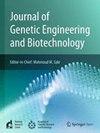免疫信息学方法在设计高覆盖mRNA多表位抗SARS-CoV-2疫苗中的应用
IF 2.8
Q3 Biochemistry, Genetics and Molecular Biology
Journal of Genetic Engineering and Biotechnology
Pub Date : 2025-06-21
DOI:10.1016/j.jgeb.2025.100524
引用次数: 0
摘要
尽管病例有所减少,但SARS-CoV-2的流行状态仍然威胁着公众健康,开发抗变异疫苗可能是预防未来感染的一种有希望的策略。在这项研究中,我们利用免疫信息学和反向疫苗学,旨在开发一种高人群覆盖率的多表位mRNA疫苗,针对SARS-CoV-2的多种变体。方法收集SARS-CoV-2相关全基因组变异序列20,567个序列,设计多变体疫苗。利用免疫信息学方法,对选定的抗原刺突和核衣壳蛋白进行分析,以预测线性B淋巴细胞(LBL)、辅助性T淋巴细胞(HTL)和细胞毒性T淋巴细胞(CTL)表位。这些表位根据抗原性、毒性、过敏原性、保护和覆盖在全球和印度尼西亚水平进行评估。鉴定的表位进一步与MHC分子进行分子对接分析,并结合设计多表位疫苗。将验证的疫苗构建体(VC)三维结构与TLR4和BCR进行分子对接。还评估了疫苗结构在引发免疫反应方面的潜力。结果预测的表位具有广泛的人群覆盖率,分别覆盖全球人口的99.99%和印度尼西亚人口的99.39%。筛选出4个LBL表位、5个HTL表位和3个CTL表位,通过连接体将其组合成一个多表位结构,该结构具有抗原性、非致敏性,长257个氨基酸,大部分结构为螺旋状(61.87%)。此外,分子对接分析揭示了验证的3D结构与TLR4和BCR受体之间的有效相互作用,而分子动力学模拟证实了VC-TLR4和VC-BCR复合物的稳定性。此外,对mRNA密码子进行优化以提高疫苗的表达效率,二级结构分析表明,设计的mRNA疫苗具有稳定的构象。结论获得了一种高人群覆盖率的mRNA候选疫苗,可诱导对多种变体SARS-CoV-2产生强大的保护性免疫应答。因此,需要进一步的研究来验证所建议的候选疫苗的安全性和有效性。本文章由计算机程序翻译,如有差异,请以英文原文为准。

An immunoinformatics approach in designing high-coverage mRNA multi-epitope vaccine against multivariant SARS-CoV-2
Background
Despite the decreasing cases, SARS-CoV-2, with its endemic status, still threatens public health, and developing a variant-proof vaccine could be a promising strategy to prevent future infection. In this study, utilizing immunoinformatics and reverse vaccinology, we aimed to develop a multi-epitope mRNA vaccine with high population coverage, targeting multiple variants of SARS-CoV-2.
Methods
To design a multivariant vaccine, 20,567 sequences consisting of all SARS-CoV-2′s variants of concern whole genome were retrieved. Utilizing an immunoinformatics approach, the selected antigens spike and nucleocapsid proteins were analyzed to predict linear B lymphocyte (LBL), helper T lymphocyte (HTL), and cytotoxic T lymphocyte (CTL) epitopes. These epitopes were evaluated based on antigenicity, toxicity, allergenicity, conservancy, and coverage at both global and Indonesian levels. The identified epitopes were further subjected to molecular docking analysis with MHC molecules and combined into the design of a multi-epitope vaccine. The validated 3D structure of the vaccine construct (VC) was used in molecular docking with TLR4 and BCR. The vaccine construct’s potential in eliciting immune responses was also assessed.
Results
The predicted epitopes demonstrated extensive population coverage, encompassing 99.99% of the global population and 99.39% of the Indonesian population, respectively. The selected epitopes consisted of four LBL, five HTL, and three CTL epitopes were combined using linkers to make a multi-epitope construct, which was antigenic, non-allergenic, 257 amino acids long, and most of the structure was coil (61.87%). Furthermore, molecular docking analysis revealed potent interactions between the validated 3D structure and the TLR4 and BCR receptors, while molecular dynamic simulations confirmed the stability of the VC-TLR4 and VC-BCR complexes. Additionally, mRNA codon optimization was performed to enhance vaccine expression efficiency, and secondary structure analysis indicated that the designed mRNA vaccine possessed a stable conformation.
Conclusion
As a result, an mRNA vaccine candidate was obtained with high population coverage and could induce a robust and protective immune response against multiple variants of SARS-CoV-2. Therefore, further studies are required to validate the safety and efficacy of the proposed vaccine candidate.
求助全文
通过发布文献求助,成功后即可免费获取论文全文。
去求助
来源期刊

Journal of Genetic Engineering and Biotechnology
Biochemistry, Genetics and Molecular Biology-Biotechnology
CiteScore
5.70
自引率
5.70%
发文量
159
审稿时长
16 weeks
期刊介绍:
Journal of genetic engineering and biotechnology is devoted to rapid publication of full-length research papers that leads to significant contribution in advancing knowledge in genetic engineering and biotechnology and provide novel perspectives in this research area. JGEB includes all major themes related to genetic engineering and recombinant DNA. The area of interest of JGEB includes but not restricted to: •Plant genetics •Animal genetics •Bacterial enzymes •Agricultural Biotechnology, •Biochemistry, •Biophysics, •Bioinformatics, •Environmental Biotechnology, •Industrial Biotechnology, •Microbial biotechnology, •Medical Biotechnology, •Bioenergy, Biosafety, •Biosecurity, •Bioethics, •GMOS, •Genomic, •Proteomic JGEB accepts
 求助内容:
求助内容: 应助结果提醒方式:
应助结果提醒方式:


